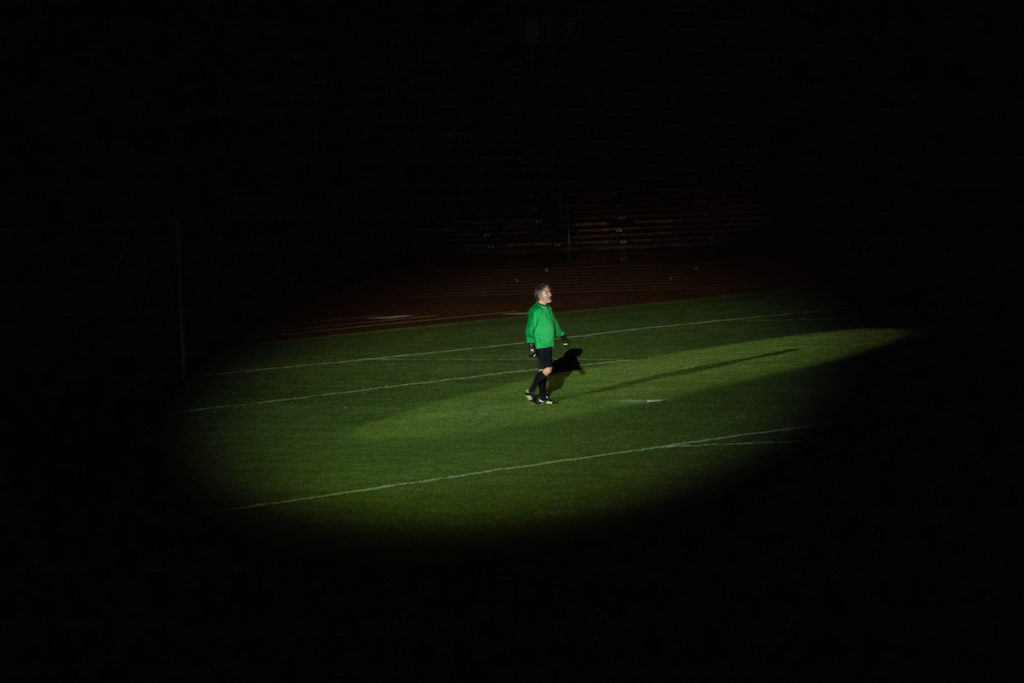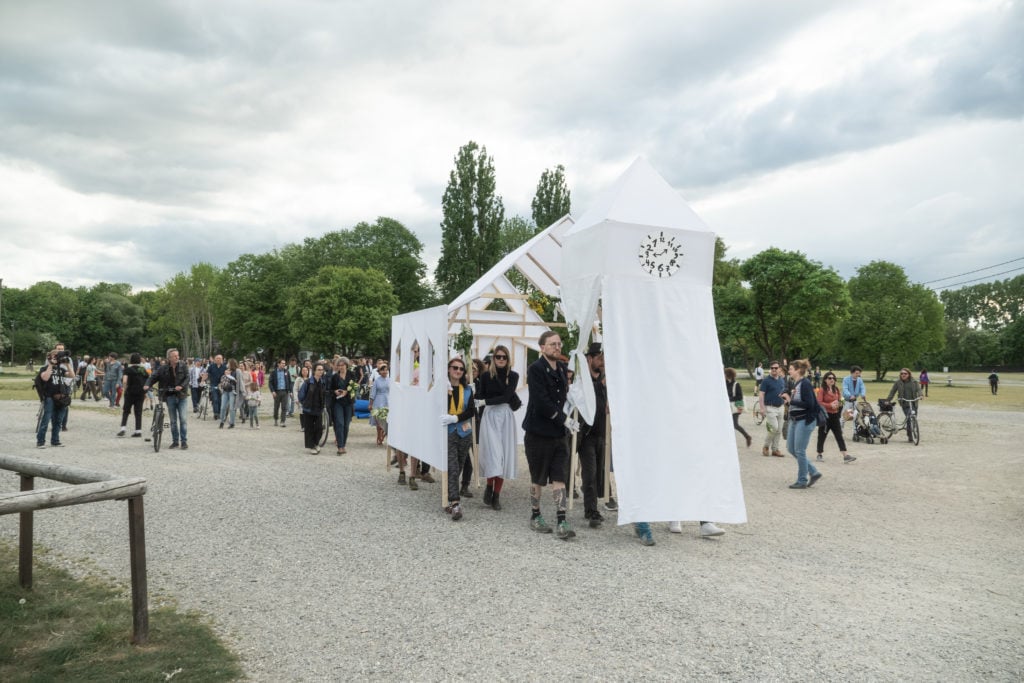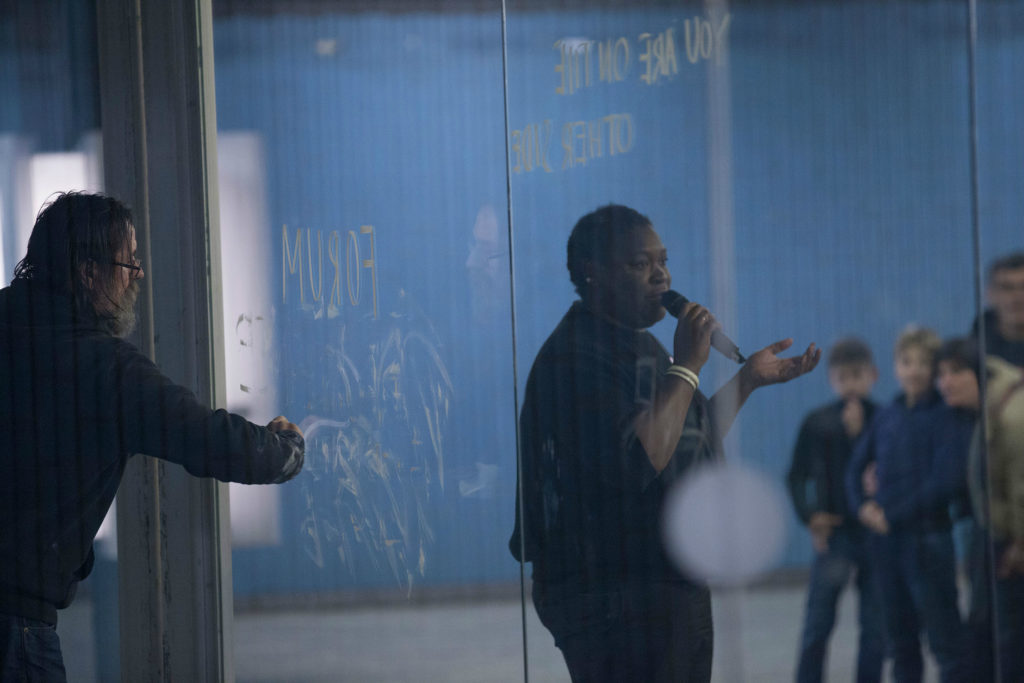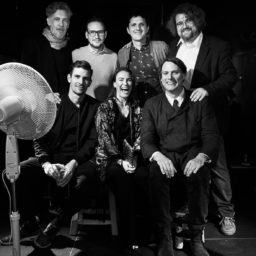In Munich’s famous Olympiastadion the East German national anthem was blaring over the loudspeakers last Monday, April 30, probably for the first time since 1989—the year the Berlin Wall was torn down and the GDR began imploding.
Two football players, representing the former West and East Germanys, ran across the pitch in a reenactment of an historic match during the 1974 World Cup. Their first encounter ended with a 1-0 victory for the East. (West Germany went on to win the competition.)
The surreal performance was a work by the Swiss artist Massimo Furlan, commissioned and staged on the occasion of the opening of Public Art Munich (PAM). The city’s quadrennial art festival has been organized this year by the Polish-born, Berlin-based curator Joanna Warsza under the title “Game Changers.”

Massimo Furlan’s as the West German goal keeper in his Olympic Stadium performance. Courtesy the artist and Public Art Munich, 2018. Copyright Paul Valentin and Michael Pfitzner.
But soon after the performance began, things started going off script. The reenactment followed the original radio commentary that the audience tuned into over headphones, but when a naked man ran across the stadium, twice, and the broadcast made no mention of a streaker, people started exchanging confused looks. Everyone finally realized that something was wrong when the actor representing East Germany didn’t get up after reenacting a foul. It took paramedics a few minutes to realize that he was actually injured. Such are the risks of performance art.

Performance by Anna McCarthy and Gabi Blum. Parade of the W(e/a)k, a procession between the East-West Peace Church to the Olympic Stadium. Courtesy the artist and Public Art Munich, 2018. Copyright Paul Valentin and Michael Pfitzner.
Putting the Public into Public Art
“I’m really not the kind of person who can curate a show in a museum,” Warsza told artnet News. “We often read curatorial statements about how art seeks to reach out, make a difference—if you really mean that, then the public realm is where it should happen.”
Her program for this edition of Public Art Munich exclusively features 20 time-based commissioned performances, each taking place over a single weekend in the event’s three-month duration. The entire program, which has budget of around €1 million ($1.2 million) from city funds, is free for the public.
“How do you think about art in public space?” asked Warsza, whose background is as a theater scholar. Her high-profile curatorial projects include organizing the public program of Manifesta 10 across venues in St Petersburg. “The old fashion way of thinking about it would be in the medium of sculpture. But I don’t think of it as ‘art in public space,’ I concentrate on the aspect of ‘public’.”
Black Sites Revealed
While all the commissioned pieces are ephemeral, some are bound to make a permanent mark on Munich, and hopefully, on German society and politics. The multimedia artist Franz Wanner has worked closely with a whistleblower from the German intelligence service, the Bundesnachrichtendienst (BND), to name its Black Sites. The intelligence service has roughly 200 such locations around the world, around half of them in Germany. The full list will be revealed on July 19, and includes the city’s famous landmark, the Frauenkirche. Its northern bell towers may still house a secret radio station, which dates from the Cold War. (The story first broke in German media in late February, and the BND announced at a press conference in Berlin that the listening station would be removed by Easter.)
The artist has also collaborated with the city’s theater on staging the work The Interrogation that same weekend, based on actual covert procedures that took place inside a black site operated from within a facility to house refugees. The work comes at a momentous time for Munich. German newspapers have been chasing Wanner for this information, and the BND in general has come under fire in recent years as details of its complicity in murders by the neo-Nazi group known as the NSU have come to light. The London-based collective Forensic Architecture has managed to prove that a BND agent was present at the time of one of the murders, It is one of the Turner prize nominee’s many investigations.)
Meanwhile, the state of Bavaria is moving to expand the spying authority of police on its civilians with a controversial law. If it passes in the state parliament this May, the Bavarian police will be able to legally tap phones, spy on suspects and confiscate mail without a warrant.

Dan Perjovschi’s performance for Public Art Munich. Copyright Paul Valentin and Michael Pfitzner.
Tectonic Shifts
It is flash points like this that caught Warsza’s attention when she devised her program for Munich. “My interest lies in performativity and context, and how these two elements come together,” she said. “Munich is a pretty conservative city, where things sometimes go wild. I’m interested in these tectonic shifts.”
The artist Michaela Melián, whose work Music From a Frontier Town will be presented this weekend, found hundreds of records left behind by the US government at the Munich Amerikahaus, the first in a series of cultural outposts that the US opened across West Germany with the mission to “reeducate” the German population after the end of the Nazi regime. As the Cold War began, these centers also served for propaganda purposes, with music being an important cultural import. (The Amerikahaus ceased its operation in Munich in 1997).
Another highlight of the program that is sure to get the attention of a crowd beyond the traditional art world also has to do with soccer. On June 2, Alexandra Pirici, fresh on the heels of her New Museum show “Co-Natural,” together with artist Jonas Lund are due to present the work N Football. It is a major production that will see the male and female junior teams of FC Bayern playing a match set to somewhat modified rules inside the Allianz Arena, designed by architects Herzog & de Meuron. “I wanted to expose some of the monetary aspects of soccer,” Pirici told artnet News. “If teams can buy players from another team,” she says, the match will ask what happens if a player is bought by the competing team in the middle of a game?
And as for the opening match, the artist Massimo Furlan remained on the field, alone, after the actor who played the GDR gaolscorer, Jürgen Sparwasser, was treated for his broken foot. Furlan stayed in character as as Sepp Maier, the West German goalkeeper, and the spotlight stayed on him, and on the ball he failed to save in 1974.
Public Art Munich runs through July 27, various venues, Munich.












